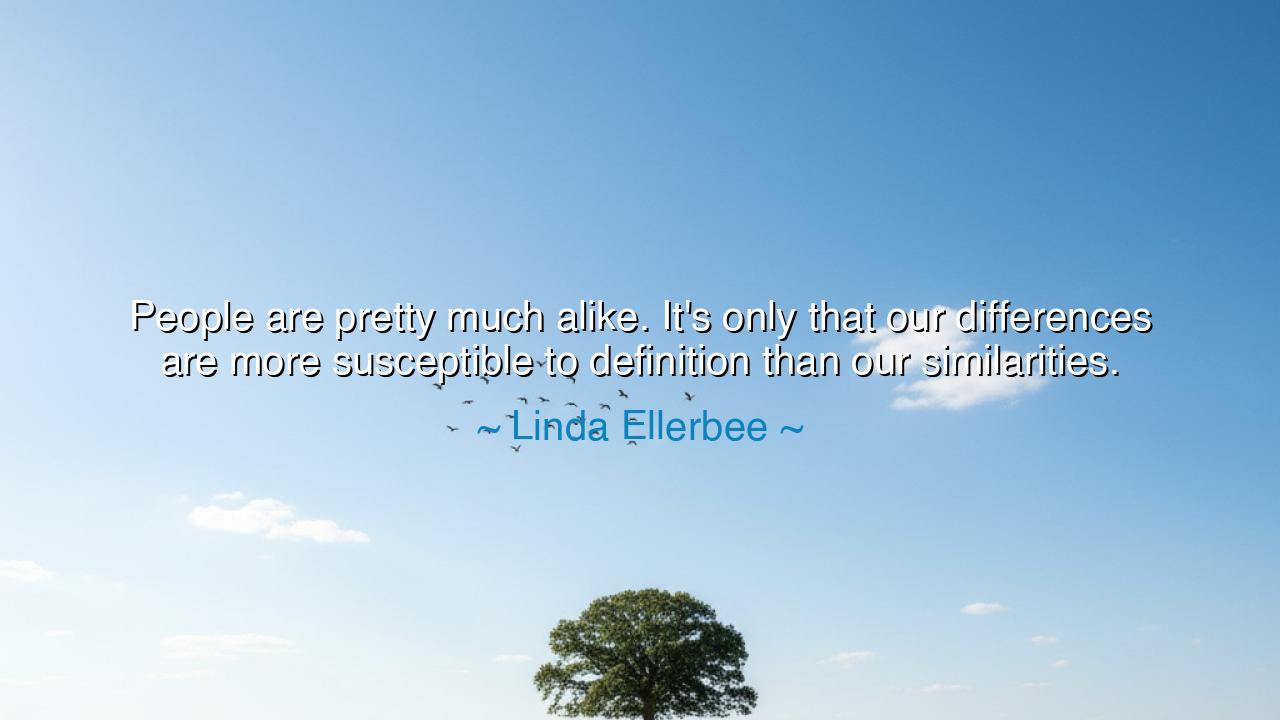
People are pretty much alike. It's only that our differences are
People are pretty much alike. It's only that our differences are more susceptible to definition than our similarities.






“People are pretty much alike. It’s only that our differences are more susceptible to definition than our similarities.” Thus spoke Linda Ellerbee, a journalist and thinker of modern times, who saw through the fog of division that often clouds the human heart. Her words shimmer with the light of wisdom: that beneath the garments of race, language, faith, and custom, the human soul beats with the same pulse. Our similarities are vast but quiet, like the ocean’s depths; our differences, though fewer, make noise upon the surface and draw the eye. So humanity, blind to its shared essence, too often mistakes the sound of difference for the truth of identity.
In the ancient days, sages said that all rivers flow to one sea. So it is with humankind. We differ in color and creed, in thought and in tongue, yet our tears taste the same, our laughter rings the same, and our hearts ache in the same silence. But these deep truths are subtle and difficult to define; they cannot be named or measured easily. What can be measured—the color of one’s skin, the pattern of one’s worship, the shape of one’s customs—these become the definitions that divide us. Ellerbee saw that the tragedy of humanity is not that we are different, but that we focus on what is easiest to describe rather than what is hardest to understand.
Linda Ellerbee, having lived through times of war, social change, and media upheaval, spoke as one who had watched people quarrel endlessly over categories—nations, ideologies, generations—while forgetting the deeper bonds of empathy and decency. Her insight arose not from abstraction, but from experience: from seeing how people of opposing sides, when stripped of symbols and rhetoric, longed for the same things—peace, dignity, and love. It is easier, she reminds us, to name what separates us than to honor what unites us. For difference can be seen and defined; similarity must be felt and lived.
Consider the story of Nelson Mandela, who, after twenty-seven years in prison, emerged not with bitterness but with grace. When he spoke to his jailers, he saw not their uniforms but their humanity. He understood that though they had divided themselves by race and power, they shared the same longing for freedom—the only difference was that some were too afraid to claim it. Mandela’s greatness lay in recognizing, as Ellerbee did, that human likeness is eternal, while difference is temporary. He did not deny difference; he transcended it, proving that shared humanity is the foundation of peace.
The ancients taught that wisdom begins with seeing the invisible. And the invisible things that unite us—love, sorrow, hope, fear—are the threads that weave the world together. To the unseeing eye, people appear distinct and distant, divided by nations or tribes. But to the wise heart, humanity is one great body, each person a vital limb. When one part suffers, all suffer; when one part heals, all are restored. Ellerbee’s words are an invitation to open our eyes not merely to what can be described, but to what can be felt—to seek the unspoken commonness that exists beyond the language of separation.
Yet the modern world, much like the ancient one, delights in definition. We build walls of description—“this one is rich,” “that one is poor,” “this one is right,” “that one is wrong.” We name our factions and enshrine our categories, mistaking these temporary labels for eternal truths. But labels divide, while experience unites. The more we define, the less we understand. To live wisely, therefore, we must learn to listen not to the noise of difference but to the quiet harmony of similarity—the shared laughter, the shared pain, the shared journey through life’s brief and wondrous hour.
The lesson, then, is this: seek what cannot be easily defined. When you meet another, do not first ask what separates you; ask what you share. Look beyond the words and symbols to the pulse beneath. Practice humility, for every soul you meet mirrors your own longing to be seen and understood. Speak gently, for the person before you carries burdens you cannot name. And remember always that what binds humanity is not the small, describable differences, but the great, undefinable oneness of the heart.
So, my child, carry forth the wisdom of Linda Ellerbee: that we are more alike than we are different, and our greatest failure is not in being divided, but in forgetting our unity. Let not the surface of the world—its noise, its conflict, its definitions—blind you to the vast sameness beneath. For when we see through the illusion of difference, we will remember what we have always been: one family, one story, one breath in the endless rhythm of time.






AAdministratorAdministrator
Welcome, honored guests. Please leave a comment, we will respond soon